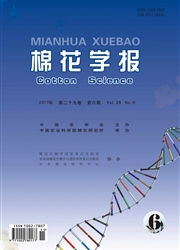

 中文摘要:
中文摘要:
在新疆气候生态条件下,设置适量化调和超量化调方式,每个化调下设3个种植密度,研究了化学调节剂(DPC)对不同密度棉花冠层结构及产量的影响。结果表明:随密度增加,两种化调量下均表现叶面积指数(LAI)增大、叶倾角(MFA)变大,株型变紧凑;但密度过大,群体散射辐射透过系数(TR)小,造成生育后期群体光合速率(CAP)较快下降。相同密度下增加化调量,盛铃后期的LAI、MFA和CAP显著降低,TR保持较高水平;群体干物质积累量少,但分配到生殖器官的比例上升。盛铃后至吐絮期的LAI、MFA和CAP与总铃数、皮棉产量均呈显著正相关,开花至吐絮期的TR与群体干物质累积量呈显著负相关。因此,生产上要实现棉花高产及超高产,应促使生育前期叶片面积稳定上升,保持盛铃后期叶片较高的面积、倾角和光合功能。
 英文摘要:
英文摘要:
In order to study the effect of growth regulators(DPC) on canopy architecture and yield characteristics of cotton at different planting densities,two elements experiment with two levels of growth regulator and three plant densities was conducted.Results showed that under different levels of growth regulator,the leaf area index(LAI) and mean foliage angle(MFA) increased as planting density increased,while the canopy transmission coefficiency for radiation penetration(TR) decreased.Very high planting density impacted the canopy structure negatively,resulting in a rapid decline of canopy photosynthetic rate(CAP).The LAI,MFA and CAP decreased with the amount of growth regulator increasing,but TR increased.Although light interception index and dry matter weight reduced,the proportion of dry-matter distributing to the reproductive organs increased rapidly.The LAI,MFA and CAP displayed a highly significant positive correlation with boll number and yields of lint at later full bolling and boll opening stage.The TR correlated negatively with dry matter of above-ground from flowering to boll opening stage.Therefore,enhancement of leaf area,mean foliage inclination angle and photosynthesis capacity during full bolling and boll opening stage could lead to increase of yield of lint.
 同期刊论文项目
同期刊论文项目
 同项目期刊论文
同项目期刊论文
 期刊信息
期刊信息
